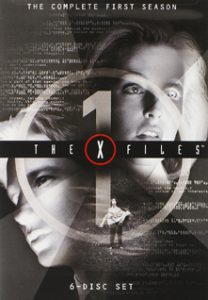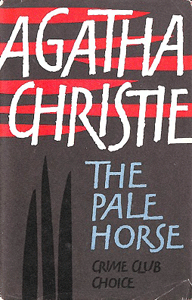Drawing on the notion that the supernatural is things science hasn’t explained yet, Agatha Christie holds a spooky vibe for most of the page count of “The Pale Horse” (1961). In the end, this is owed to her veteran strength as a writer more so than detailed scientific theorizing about the power of a “death wish.” But I still thoroughly enjoyed reading it and guessing what the answer would be.
The witching hour
As usual, she tricked me. I was so focused on being skeptical about the three “witches” in The Pale Horse (a former pub turned into a home with a séance room) that I ended up being too credulous of another character’s story. Christie again reminds us to “trust no one,” but I guess the problem is that “I want to believe.”
In “The Pale Horse,” she sets Marple and Poirot aside and gives us one-off narrator and amateur sleuth Mark Easterbrook. Although his job as a history book writer doesn’t precisely make him an Everyman, he fits the bill closely enough. He’s friends with fellow author Ariadne Oliver, who pops in to accidentally drop him some key information, but she’s not in the story much.

“The Pale Horse” (1961)
Author: Agatha Christie
Genre: Mystery
Series: Ariadne Oliver No. 5
Setting: London, Bournemouth and Much Deeping, England, 1961
Being a self-employed writer allows Mark free time and flexibility. He’s just a guy who hears the phrase “the Pale Horse” mentioned in a few unrelated conversations and can’t let his curiosity go. He’s actually not involved with the inciting event (some rare chapters are not from his POV).
Father Gorman receives a list of names in a deathbed confessional from Mrs. Davis. But then he’s murdered. Police surgeon Jim Corrigan finds the list in Gorman’s shoe. Mark then hears about the list from Corrigan and begins to tentatively investigate. Whew.
Christie doesn’t break from her core mystery structure much, but “The Pale Horse” for quite a while feels like a special novel. The way Mark has to put pieces together makes for a bigger-than-usual puzzle, although not one that’s unsolvable.
A couple of sleuths
Mark teams up with Ginger Corrigan (no relation to Jim) in a throwback to Tommy & Tuppence and other cute mystery-solving team-ups. The unspoken but budding romance is one thing I did see coming. I feel a little bad for poor Hermia Redcliffe, left to wallow from Mark’s rejection off-page.
A couple of standout sequences help “The Pale Horse” stand out. In a ceremony at the titular house, Mark sees how the witches supposedly curse a selected target with impending death. Before that, he finds the broker of these supernatural assassinations, who indirectly (and creepily) takes “bets” on the victims’ life as a substitute for payment. (This supposedly gives him legal protection, but I very much doubt if it would.)

The lead suspect, rich but wheelchair-bound Venables, is fascinating. If he can’t walk, how could he possibly have been seen stalking Gorman on that fateful night?
Although I never suspected “The Pale Horse’s” black magic was real, it definitely creates a vibe. Plus, I couldn’t totally dismiss it, since Christie has written some stories where the solution does seem to be supernatural (although these tend to be short stories, such as the Mr. Quin yarns and “The Dressmaker’s Doll,” rather than novels).
But even judged as a plain ole mystery puzzle, “The Pale Horse” is a good one. The pieces satisfyingly fit into place by the end, and the ground settles under our feet again in the world of infinite possibilities Christie has hinted at.
Sleuthing Sunday reviews an Agatha Christie book or adaptation. Click here to visit our Agatha Christie Zone.

